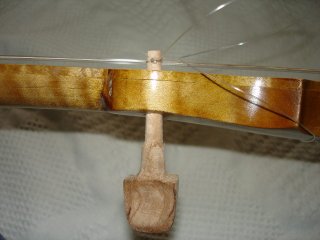
Another week has gone by. The new finish is now completely dry. I put the strings back on the banjo (again). I did not take any photographs of that process because I suspect that you are sick of looking at them and I am certainly sick of taking them. Stringing it up again was not much different from the other times I did it, so just use your imagination.
The banjo plays OK, and with the taller bridge and the newly flattened fingerboard there are few buzzes. There is still a slight buzz on the 4th string just above where the 5th fret would be. It is only in that one place, and I have avoided it by moving the bridge closer to the neck to move that note up out of the hole. I will have to think of some ideas about how to fix the problem, but for now the banjo plays and sounds nice. The weather is too cold (late November) to work on it any more so I will leave that project until next Spring.
Since any further work will have to wait, I am declaring that the banjo is done. I suppose that I should take a bunch of photographs of it and post them to show what a wonderful job I did, and I will certainly do that. Unfortunately, there are some places on the instrument that I did rather badly, and since this was intended to be a learning experience, I am going to post some photos of my mistakes before bragging.
So, here are the major screwups I made on the banjo and what I would do differently on a subsequent instrument.
First of all, the 5th string peg is not perpendicular to the neck. I don't have a drill press, so I just eyeballed it. Next time I would be more careful in making sure that the hole is drilled perpendicular to the neck surface. You can see the slant of the peg.

You can also see that the peg is just a bit too long. I could easily cut a half inch off of the length and improve the looks. I will also have to put some kind of finish on the peg buttons since they look pretty crude like that.
I think that cosmetically the worst mistake is the neck to gourd joint. It is just not very tight.
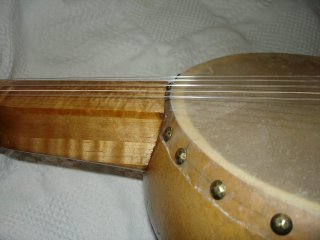
I should have spent a lot more time and effort on making that joint better. I stopped working on it because I was worried that I was making the fit of the dowel stick in the gourd hole too loose. It was supposed to be a friction fit, and my carving skills were just not up to it. It was also getting late in the season, and I wanted to get the banjo done before it got too cold outside to work on it.
I needn't have worried so much about the tight fit of the dowel stick in the gourd. The banjo is held together by string tension anyway, so as long as there is not a lot of slop, I was doing OK with it. I still might take the banjo apart next Summer and do some more work to improve that joint.
Another thing that is disappoionting about the neck joint is that the surface of the fingerboard turned out too high. It sits about 1/8" above the surface of the head.
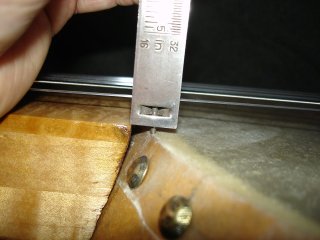
This makes the problem of buzzing strings worse because it puts them closer to the surface of the neck than they should be.
While we are looking at the neck joint, scan down to the tacks right next to it. Here is a closeup.
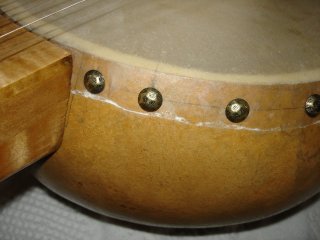
I have no idea what kind of a brain cramp I suffered when I placed that tack. It looks like I put it right on the mark too (which is visible under the head), and yet it is way off center. The rest of the tacks seem to be fine with respect to their positions. Strange.
You can also see the ugly stain in the endgrain of the neck heel. I never did figure out what soaked into the wood to do that. Makes it look sort of like an antique though, doesn't it? So we will call it a "feature".
Our next stop is up at the peghead. Here is a photo to look at.
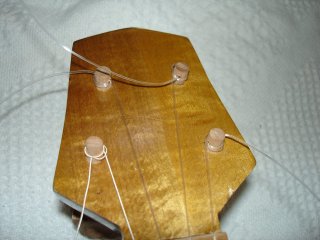
Right down at the lower right there is a chip out of the peghead overlay. I don't know when it happened, but there it is. There is also a long scratch right in the middle of the peghead, although it is difficult to see it in the photo. I know that the scratch happened when I dropped the neck on the workbench. Dropping the neck was a major mistake, and I will take great pains to avoid doing that in the future.
Another thing that you cannot see very well is that the two top peg holes are not aligned horizontally. The one on the right is farther up. I noticed that I had done that when I drilled the holes, but there was not much I could do about it. How do you move a hole? I also drilled the two top holes too close together. You can see these problems better on the back side of the peghead.
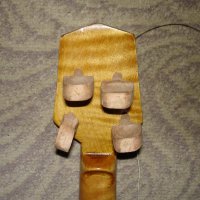
The peg buttons do clear each other, but there is very little clearance for fingers. I forgot about the fingers. Next time I will take into account that I will need fingers to tune the banjo.
Next problem: The neck angle is too steep. I thought that I was being very conservative when I did the calculations and that it would be too shallow if anything. I was wrong. I measured the neck angle using a yardstick. I put the yardstick down on the head of the banjo like this.
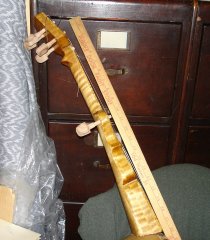
Then I measured the drop of the neck at the nut.
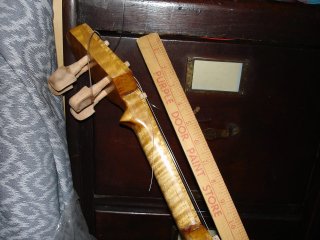
I measured the distance from the bottom of the yardstick to the nut and got 3/4". If I add to that the 1/8" that the neck is above the head I have a distance of 7/8" = 0.875". Knowing that the length of the neck from the heel to the nut is 19" I can calculate the angle of the neck.
n = length of the neck = 19"
d = deflection downward at the nut = 0.875"
a = angle of the neck
tan(a) = d / n = 0.875 / 19 = 0.046
a = arcTan(0.046) = 2.64 degrees.
My original calculations were to provide a neck angle of 2.5 degrees (reduced to 2 degrees to account for possible errors). Those calculations plus some Kentucky windage got me pretty close to my goal. However...
The angle of the neck on this banjo would be just about right if it were a steel-reinforced bluegrass banjo strung with steel strings. The action is quite low without allowing the strings to hit the neck. But the tolerances on this banjo are so loose that the angle is too steep for the gourd banjo.
With the natural materials used in the making of this instrument, it is not as tight and rigid as a modern banjo. The head is natural skin, so it moves up and down with the changes in humidity, and I am sure that the gourd flexes under the string tension. Also, those fat nylon strings vibrate in a wider arc than do steel strings. Next time, I would make less of an angle for the neck.
Finally, I had to make a monster bridge to make up for the neck angle and the less than perfectly straight fingerboard. Here is a photo of the bridge with a normal 5/8" banjo bridge sitting next to it. That's a monster! But it works.
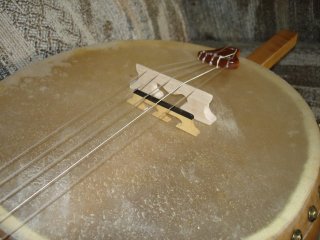
OK, here is a short list to summarize what I would do diferently next time.
That is enough of that. Here is the nice stuff.
Now on to the photos of my banjo where I can brag.